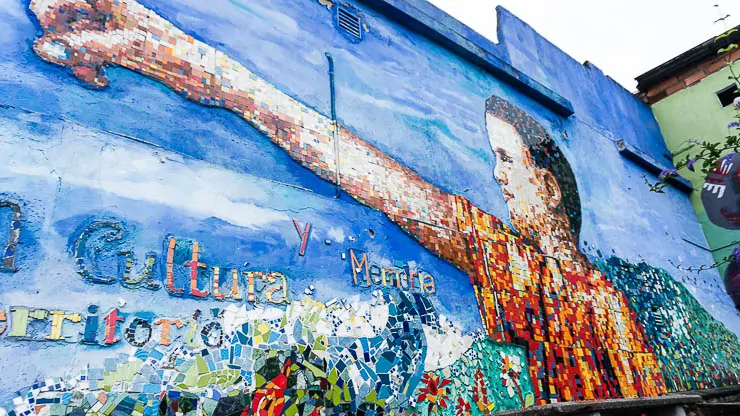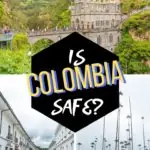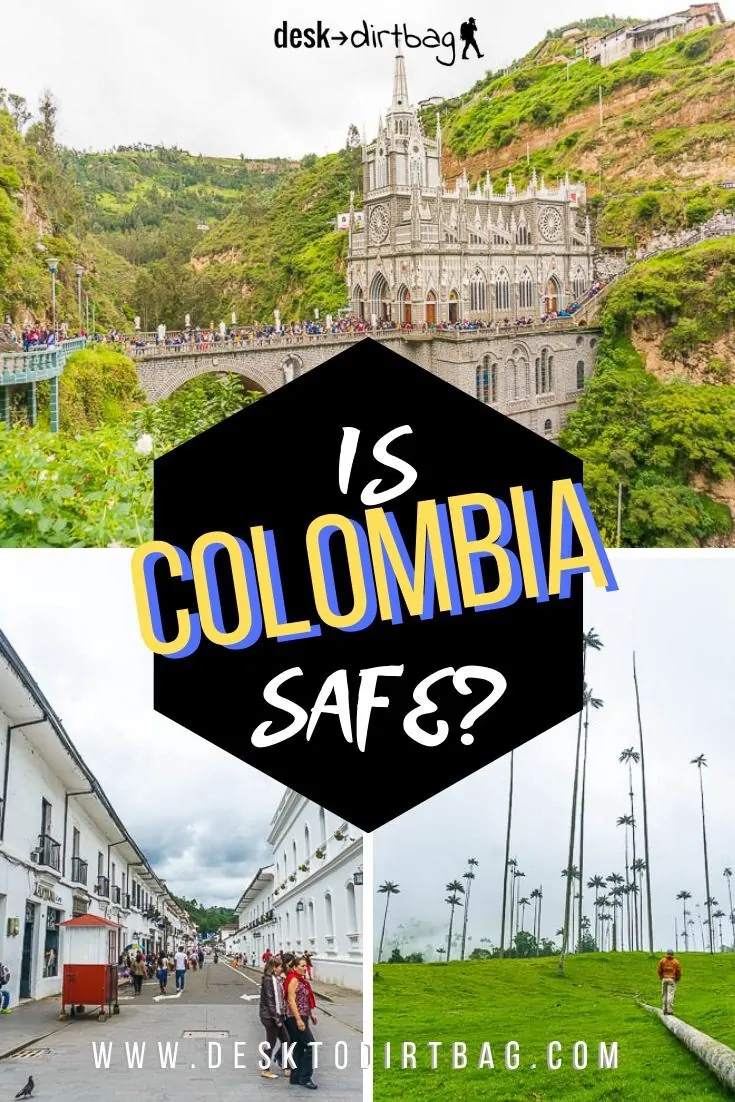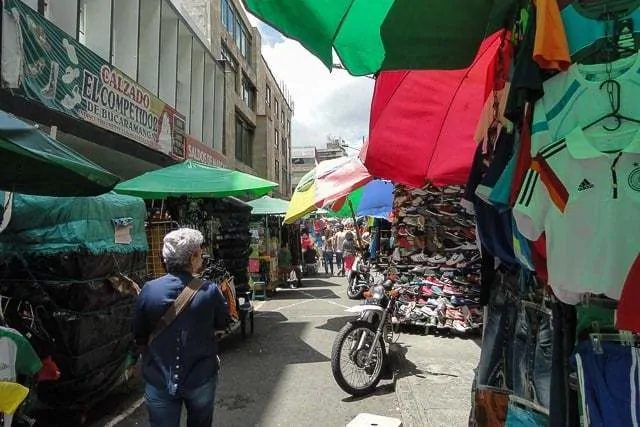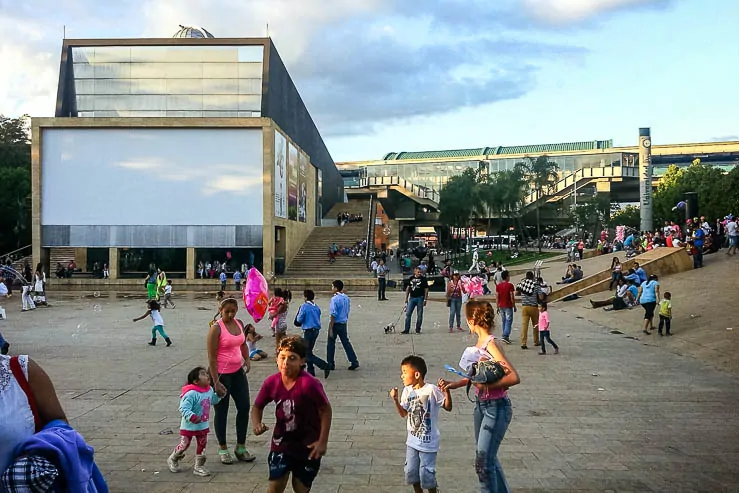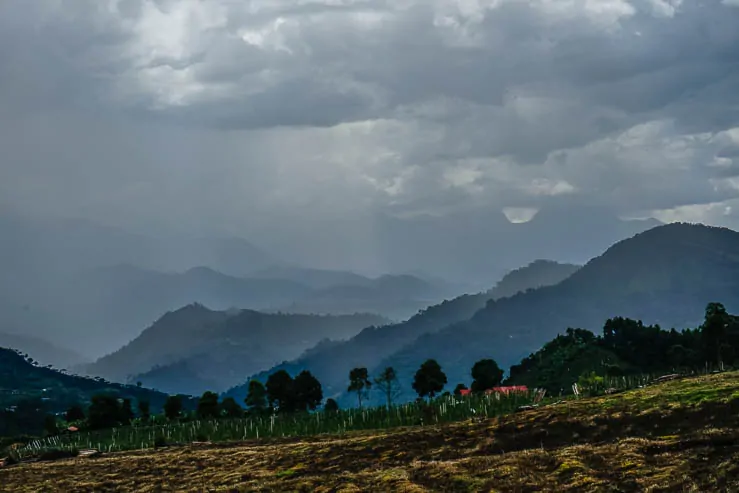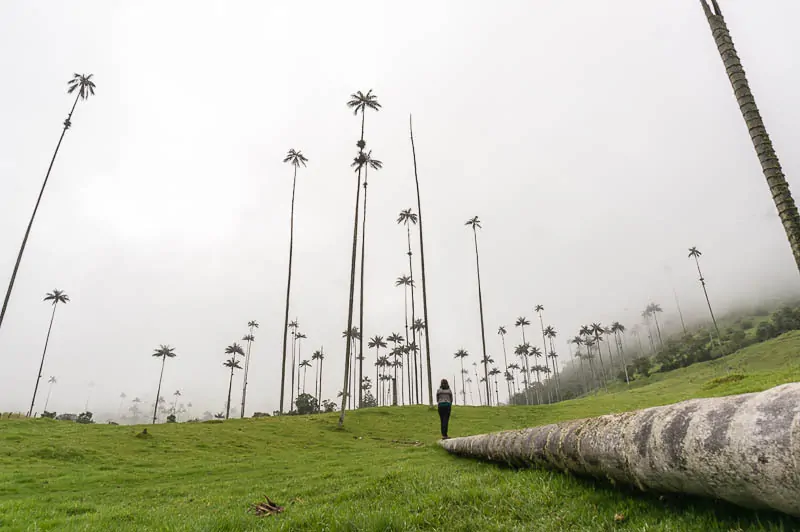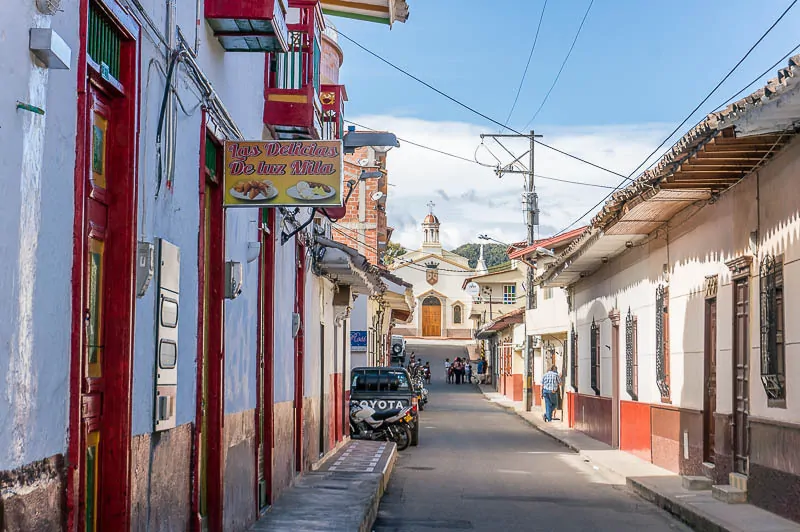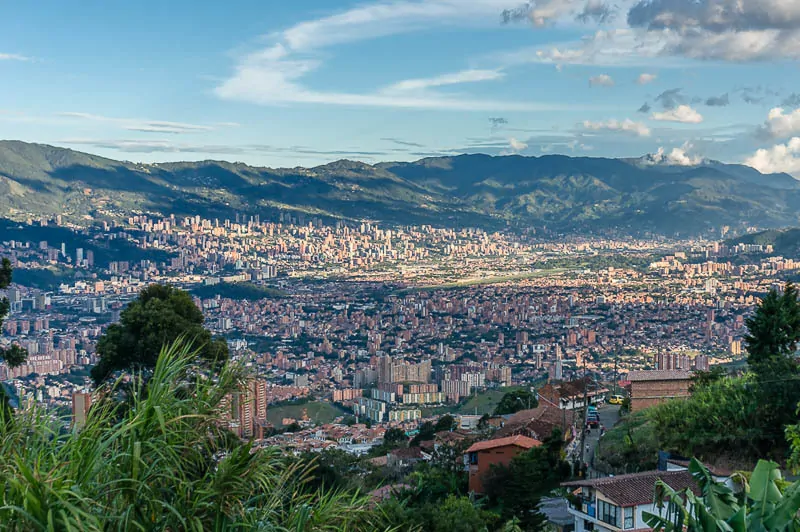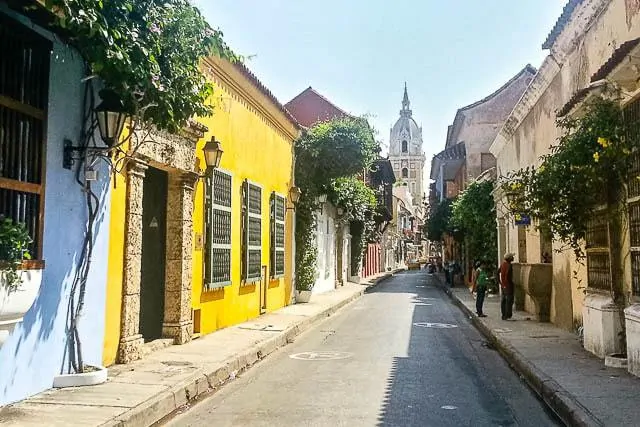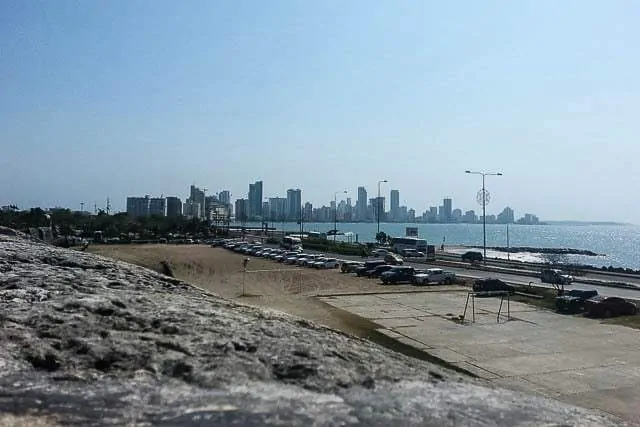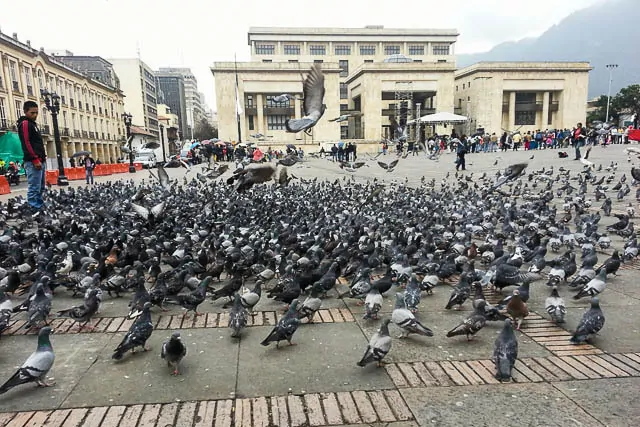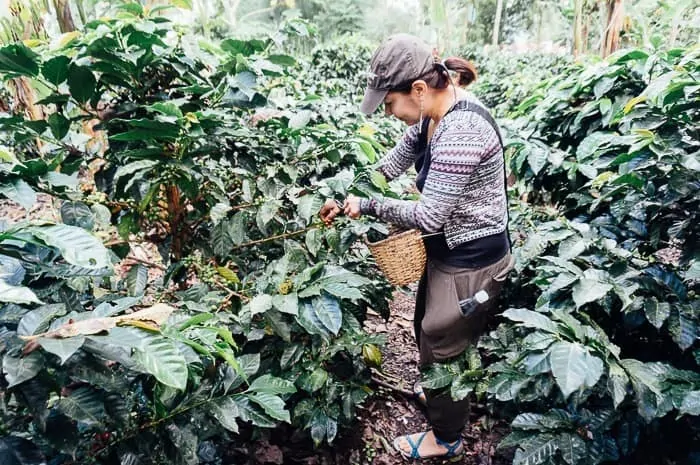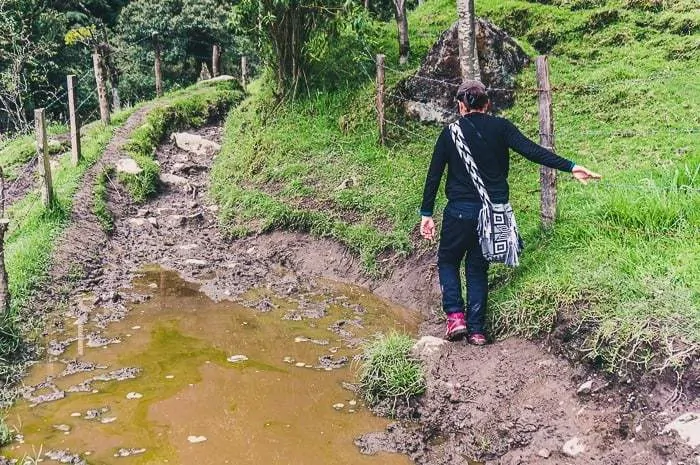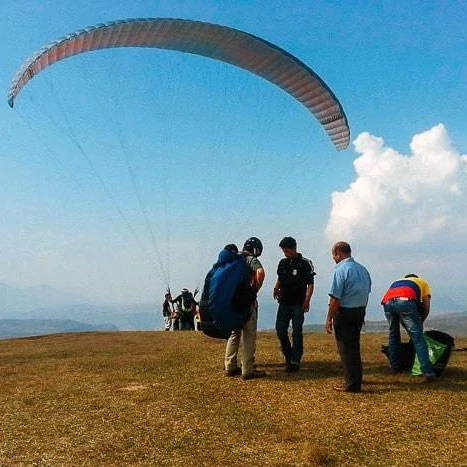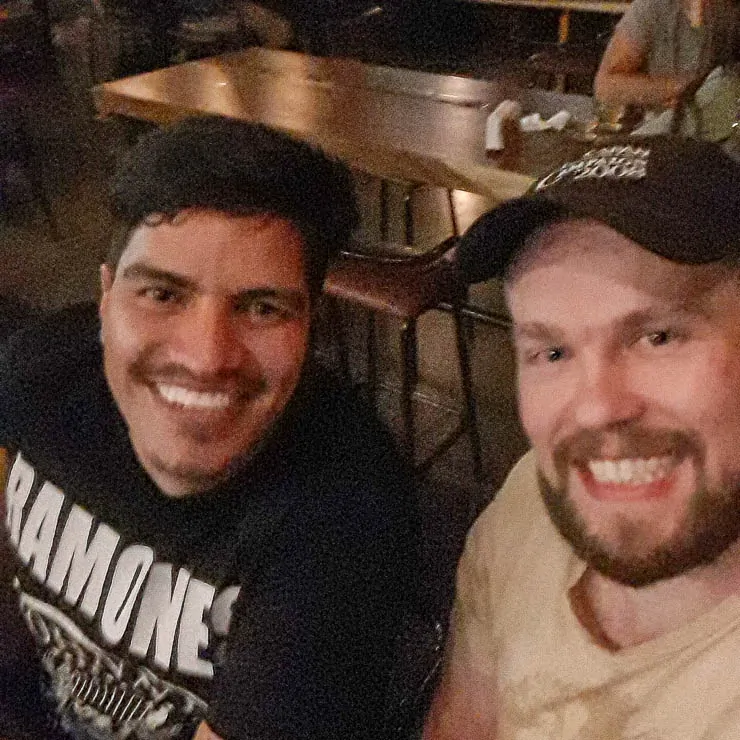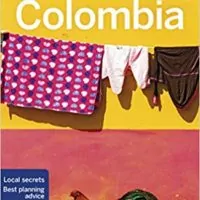Perhaps one of the most frequent questions I get as a travel writer who has been living in Colombia on and off for more than three years in total is: “is Colombia safe?” It’s a valid question, rooted in the decades of insecurity that Colombia suffered first at the hands of warring political factions and then exacerbated by the drug trade.
The only news that most of us English speakers had ever heard about Colombia is bad news. War, civil unrest, bloodshed, bombs, drug trafficking, Pablo Escobar, Narcos, FARC, kidnapping, and on and on.
Fortunately, the word is starting to get out thanks to travel sites like mine, that Colombia today isn’t anything like its reputation of yesteryear during the civil war.
Things have changed here in Colombia for the better, undoubtedly, but many still question their safety in Colombia or want to know what the reality on the ground is. Or maybe you have gotten a bad idea about Colombia travel or started to have second thoughts if you’ve read some of the travel advisories for Colombia from the US State Department…
They make it sound like express kidnapping, druggings, bombs, and violence are an everyday part of life, but that just isn’t the case. I usually joke with people about what the US State Department travel warning would look like for the United States… Mass shootings, social unrest, drug addiction, police brutality, etc.
Back to our question about whether Colombia is safe… It can be tricky to answer because as with anything, things aren’t black and white or a simple yes or no. I can’t just say it’s either safe or dangerous, so I want to tackle the matter as best as I can in terms of the reality on the ground for a foreigner traveling in Colombia, along with some practical travel tips for staying safe in Colombia.
So, Is Colombia Safe?
As I alluded to already, the bad days of Colombia’s past are long gone, but that doesn’t mean that things are perfect here, of course. Crime rates have gone down, but they are still pretty elevated when it comes to petty crime, especially if you consider the fact that much of it simply goes unreported.
If I had to boil things down, I’d say that Colombia is generally safe, pretty similar to almost all of Latin America.
What that means is that you don’t really need to worry about kidnapping or violence or things of that nature. That just isn’t a concern throughout the vast majority of places that tourists would be visiting.
That does mean, however, that like the rest of Latin America, you need to be concerned with theft, robbery, and similar sorts of crime. Even so, that isn’t “likely” to happen to you, but is a possibility if you aren’t street smart and/or get unlucky.
Honestly, there’s a lot to love about life here and plenty of reasons to visit Colombia but the insecurity is definitely one of the bad things about Colombia… There’s no getting around that.
The Average Colombian
First, a little context: the average Colombian comes from a very disadvantaged position and socioeconomic status. As I’ve said, things used to be very bad in Colombia, meaning that investments in education and infrastructure are still relatively new, and as a result, lots of people have fallen through the cracks over the past few decades, along with their offspring.
In every major city of Colombia, you will see barrios populares which are basically slums or shantytowns on the margins of society. People here live in informal settlements and survive on very little. Many of these people first arrived to the cities because they were physically displaced by the violence taking place in the countryside… They were run off of their land by rebels and paramilitary groups and settled in the only places they could… Unoccupied land on the edges of big cities. Most of these people lost what little they did have in the process of fleeing.
Today, that level of insecurity is gone, but many of those people still have very little. Unemployment is incredibly high in Colombia, but much of that is due to the fact that so many Colombians work in the informal job market, selling whatever they can or working in under the table jobs.
Consider for a moment that the minimum wage here in Colombia is less than $300 per month, far less than what one needs to really survive here, and then consider how many people today (locals too) are walking around with cellphones worth more than many people here make in a month…
Crime and Theft in Colombia
Petty crime, robbery, and theft is the biggest concern for any tourist coming to Colombia. Actually, it is also the biggest concern of local Colombians, as well, not something exclusively directed at travelers.
But, as an easily noticeable foreigner, you may be targeted as someone who a thief believes to be more wealthy, likely carrying a higher quality, more expensive cellphone, and potentially more cash.
That’s just the fact of the matter, which is why it is important that you don’t really show any outward signs of wealth or flash things around here.
After more than three years living in Colombia and traveling basically from one end of the country to the other (multiple times), I have not personally been targeted for theft, violence, or robbery… Knock on wood.
As a foreign tourist traveling through for a short amount of time, you’re also not likely to experience anything. It’s certainly possible, but it is still a very rare occurrence.
There was one incident when I was traveling with my girlfriend and a motorcycle thief pulled up next to her and attempted to take off her purse… Fortunately, though, the strap of the purse broke off completely and the purse fell to the ground. Andrea was also thrown to the ground and slightly injured in the process though.
We believe in retrospect that the taxi driver we used was working with the thief, and that’s how we fell victim that one time.
But again, that is one bad experience in years of being here… Bad luck that basically came down to being in the wrong place at the wrong time and picking the wrong cab. I’ve had bad luck in the United States too, like that one time I got robbed while walking back to my place on Capitol Hill, a handful of blocks from the US Capitol Building.
Probabilities here may be higher here though… And in any case, you can drastically minimize your chances of anything happening to you too by adopting the local Colombian perspective of “No Dar Papaya”…
No Dar Papaya
No Dar Papaya literally translates to “don’t give papaya” and this all too common refrain basically means don’t make yourself an easy target. In this sense, they mean don’t offer up papaya because someone will take your papaya, and papaya, in this case, means basically anything of value.
For example, if you are walking around with your cellphone in your hand, you are giving papaya. Come across the wrong someone, and they are going to take your papaya. Perhaps at gun or knifepoint.
If you are walking back to your hostel alone, drunk, and in the middle of the night, you are definitely giving papaya.
The whole “No Dar Papaya” thing can be construed a bit as a victim-blaming, which it is, but it has evolved from a place that suffered from insecurity far worse than it is today. If you’re doing something slightly dumb here (which could be totally normal in other countries) and you become a victim, expect to hear lots of people telling you that you gave papaya and basically had it coming to you.
Colombia Safety Tips and Info
I’ve been here a long time, so I’ve heard all sorts of stories… I’ve heard of a group of four foreigners being robbed at knifepoint in the sleepy little tourist town of Salento. I’ve seen a car full of Colombians getting robbed in the middle of the day on a Sunday on the corner of one of the most popular parks in Medellin (Parque Lleras). I’ve heard of robbers jumping out of the back of taxis, or motorcycle robberies, or much more.
Unfortunately, things can and do happen here in almost any neighborhood (the nicest ones more often than not) and at any time of day. Staying safe here isn’t as simple as “stay out of the sketchy neighborhoods” and “don’t walk alone at night.”
If we’re being truthful, there are far more foreigners robbed in the nice, upscale neighborhood of Poblado than there are robbed in poorer neighborhoods like Santo Domingo or Comuna 13 (and plenty of foreigners visit there too).
Staying safe in Colombia comes down to good practices, not “dando papaya,” and just not having bad luck too…
But here are some practical tips about staying safe in Colombia:
Don’t Show Wealth
Avoid showing outward signs of wealth in public, whether through fancy clothes, fancy watches/jewelry, electronics, etc. It is assumed that a foreigner here on vacation (even a poor budget traveler) would have more valuable things and more money in their pocket than the average Colombian. Even though that is probably true, you don’t want to accidentally prove that.
Careful with your Cell
Cell phones are the #1 target… Again, even the cheapest cellphone is worth about a month of the minimum wage, and a good cellphone can be like three months worth. Avoid as much as possible using your cellphone nonchalantly on the street.
Sure, I take photos with my cellphone, I order Ubers, I answer calls occasionally, and more. But I always try to do so as discreetly as possible, whether that means ducking away from the street or waiting until I’m inside a local business to do whatever it is I need to do on my phone.
Be Careful with Taxis
Taxis are where you are most likely to encounter problems (more than the “illegal” Uber)… It could be just standard taxi scams of overcharging, running up the meter, or giving you the runaround, or they could be working with criminals.
Many locals hate and distrust taxi drivers, you should also distrust them. There are official taxi stands in many cities which are preferable to waving one down on the street. There is also an app called EasyTaxi where you can call a taxi much like Uber.
Whenever you are in a car of any sort here, be sure to keep the windows rolled almost all the way up, valuables out of sight, including cellphones in your pockets and backpacks/purses on the ground (motorcyclists, more on them in a minute, can often be seen peaking into cars at stoplights), and you may want to keep the door locked.
Be Wary of Motorcycles
Motorcycle riders are the biggest perpetrators of crime in the cities because they are already masked (often with a full-face helmet) and they can make a quick and easy getaway as the split the lanes in between heavily congested traffic.
These motorcyclists often work in teams, either with two guys on one bike (suspicious), two separate motorcycles or work with tips from taxi drivers.
Honestly, it is tough to keep your eyes out when there are so many taxis all over Colombia, but you should be cautious that they are your #1 threat.
Handling Your Money in Colombia
Carry a money pick or small wallet with the cash that you need for the day in your front pocket. Any other money that you don’t need for the day should be stowed somewhere else like a money belt or what have you. Colombia is still a mostly cash country, but you can use a travel credit card in many larger businesses throughout the country, which is what I recommend to do whenever possible.
If you are going to withdraw money from an ATM, try to always do so from inside of large establishments like supermarkets or malls rather than withdrawing money from ATMs on the street. I usually try and shake the place where you insert the debit card to try and see if there is a skimmer there.
My preference is to withdraw smaller amounts of cash more frequently rather than large amounts of cash all at once. I can do this because my back charges no fees and actually reimburses all out-of-network ATM fees. Read more about my travel banking recommendations.
Avoiding Pickpockets
Honestly, pickpockets aren’t super common here but it does happen. Try to keep your most important belongings in your front pockets and mind yourself on crowded public transportation.
If you are using a large backpacker-style backpack, then be sure to use a pack cover while walking around to prevent wandering hands. If you’ve got a small bag or daypack, be sure to keep it in front of you in crowded areas, often downtown… You’ll know when you see locals wearing their backpacks on their chest rather than their backs.
Advice for Partying
Never leave your drink alone or unattended. There have been instances of people being drugged (usually by their drink) with scopolamine for what they call an express kidnapping. That is super rare but it’s also a good idea to not overdo it with the drinks here because then you are most definitely “giving papaya” and making yourself the easy mark.
On that note, we should also mention vice tourism, aka those people who come to indulge in drugs and prostitution in Colombia. This is definitely the fastest way to run into problems if that is what you are looking for. Your probabilities of having something go wrong and being involved in theft, robbery, etc, go up almost exponentially.
Also important to note that Colombians are highly fed-up with foreigners coming here for vice tourism and there is an increasing backlash against this type of tourism. So please don’t come here for that and don’t engage in that type of behavior here. Capiche?
Health Safety Tips in Colombia
There aren’t a ton of big worries when it comes to general health and wellness in Colombia, but I will mention a few things because you’re more likely to have a bout of gastrointestinal problems that experience a robbery.
Water: Do not trust the water outside of cities like Medellin or perhaps Bogota. Always ask knowledgable locals about water quality, but don’t trust blindly. Even in places like Medellin (which has excellent drinking water), you can find old buildings with bad pipes. I carry a SteriPen for treating questionable drinking water and would recommend you do the same. Please reduce your use of disposable plastic.
Colombian Food: The general level of hygiene and sanitation here is pretty good, certainly much better than places like Mexico or even Ecuador. Be careful with street food because you never really know about the level of sanitation (usually no water to wash hands) or if the food has been properly stored. Be wary as well of food that has been left out all day, particularly things like empanadas and pasteles which have meat and then sit under the tropical sun.
Sun: Speaking of which, be mindful of using sunscreen. The sun here is definitely much stronger near the equator and you will burn much quicker here. Regular use of sunscreen (and reapplying if you will be out all day) is important and often overlooked. Sunscreen here is quite expensive, so it is best to bring some from home.
Emergencies: Both medical and dental care in the country is of very high quality in major cities and you can expect prompt and affordable coverage even when paying out of pocket and without insurance. That being said, you should be sure to have travel insurance for Colombia to protect yourself from potentially costly accidents. I use and recommend World Nomads.
Natural Disasters in Colombia: Rare incidents include volcanic activity and smaller earthquakes are known to happen here from time to time (I’ve felt more here in a few years in Medellin than a lifetime in the Seattle area) along with stronger ones near the border with Ecuador.
But the most frequent sorts of problems are related to heavy tropical rains which can cause flooding or more often landslides. There have certainly been tragic cases related to landslides but the biggest problems are usually just roads getting blocked for hours or sometimes a day or two. Even the main highways are usually small two-lane roads that wind through the mountains. Be sure to ask locals about current conditions, especially when traveling during the rainy season.
See more about the best time to travel to Colombia.
Is Colombia Safe to Travel Alone?
Yes, Colombia is perfectly safe to travel alone. Obviously, there are some benefits to having a travel companion when it comes to safety… Namely, things like someone to watch your stuff while you run to the bathroom at a bus station, the safety boost (even just psychologically) that comes with traveling in numbers, and what have you.
That being said, I’ve traveled alone at times throughout Colombia and it is basically just the same when it comes to safety. Indeed, traveling alone at times can be better because you are more easily able to make connections with friendly locals and you can always very easily meet fellow travelers at hostels.
I would strongly recommend against going out and partying alone though without some sort of wingman/woman to watch your back.
Colombian Scams and Dealing with Locals
99.9 percent of locals are super honest and happy to have you in their country, meaning that they are looking out for your best interest and want you to have a safe and fun trip. Tourism is fairly new here in Colombia since the bad old days have ended.
Compared to almost any other country in Latin America, I can honestly say that Colombia has some of the fewest attempts to price gouge or rip off tourists that I’ve ever seen. I’m not making that up… After so long here, I’ve seen very few attempts to inflate prices or rip me off.
By this, I mean that you aren’t likely to see anyone inflating their prices at a restaurant or store or other business just because you are a tourist. The only exceptions to this would be taxi drivers, particularly those in cities like Cartagena where they have no taximeter and you must rely on haggling (always ask a local for what the normal price should be).
I still prefer to use Uber for the most part, even if it is illegal here. Officials are cracking down a little more lately on Uber drivers, so that may complicate things in the near future. The taxi mafia is strong in many parts of Colombia.
Cartagena is probably the worst in terms of trying to rip off tourists (thanks to its long-time status as Colombia’s most popular tourist destination) with things like massages on the beach, taxi drivers, different prices for tourists, etc. It’s still not super common in Cartagena but something to look out for.
In the rest of the country, I’d go so far as to say that it is super uncommon. More common would be accidentally paying too much and having someone chase you down the street because of that (something that has actually happened) or simply being forthright and giving you the correct change if you misunderstand or make a mistake.
People here are honest, friendly, and the vast majority aren’t looking to milk the tourist for everything they’ve got, unlike many other destinations I’ve been to. Getting hassled is something I detest as a traveler, and something I love about Colombia is that it is very few and far between, even in some smaller and more touristy towns.
Comparing Colombia to other countries in Latin America, I can also say that it is refreshing to see police officers here are not corrupt whatsoever (with tourists) and I’ve never had one instance of them trying to shake me down for money.
On the contrary, most police officers are eager to help foreigners and I’ve had a number of them go out of their way for me, walking me to a destination I couldn’t find, or just going above and beyond. Unlike Mexico (or the United States, for that matter), you don’t have to try to avoid the police here for fear that you’ll be asked for a bribe or end up getting a ticket for god know’s what.
The Safest Cities in Colombia
Again, things can happen anywhere, but if we are trying to generalize about the safest destinations for travelers among the big cities, I’d have to say that Cartagena is the safest (along with much of the Caribbean Coast), followed up by mid-size towns like Manizales, Santa Marta, Bucaramanga, followed up by the big city of Medellin, after that, I’d place Bogota which is a sprawling massive city (and all the problems that entails), followed up by Cali which to me is the least safe of the major cities. Then there are some places like Buenaventura or Cucuta which I would recommend against traveling at all.
These are my own personal observations, but again, unfortunately, things happen here in cities or towns of all sizes so it is important to observe the safety recommendations above. There is still a lot of underlying distrust, even among locals, about rural areas which were the center for conflict before and you’ll probably hear warnings about traveling between cities at night, but realistically most of that danger is all but gone.
Is Colombia Safe for Novice Travelers?
I think this is the more important question because the perception of safety is obviously relative. If you have never traveled outside your small hometown and think that anyone who speaks Spanish is a criminal, then you are probably going to be very scared of coming to Colombia.
If on the other hand, you’re accustomed to big city life and have a bit of street smarts and experience traveling to other destinations in Latin America or the developing world, then you’re probably not going to feel or see anything different here in Colombia.
I’m one of those people who has traveled to what some may consider scary or dangerous countries like Yemen, Mexico, or Colombia, and I’ve lived in Washington D.C. (which has its own problems with crime), so all of that colors my experience.
I wouldn’t necessarily recommend Colombia as the best first destination for traveling overseas, but you could do worse.
Colombia was my first long trip to Latin America, having only spent a week or so in Mexico and a week in Costa Rica the first time I came here.
Honestly, Colombia is a beautiful country that makes for an amazing destination in South America and you’ll probably be fine here if you use common sense.
Is Colombia Safe for Female Travelers?
I’m not a woman, so I can’t personally speak to that. I can only relay what I’ve heard from others or the perspective of my girlfriend (a local Colombian). In terms of catcalls and unwanted advances, Colombia is much more chill than many destinations, even places like Italy.
Do realize that locals will frequently call you “mi amor” (my love) which is not actually flirting or any sort of advance but just a term that men use when speaking to women here. People speak more affectionately, even with strangers, than most of us are accustomed to. It isn’t unusual at all for your taxi driver to say “mi amor” or for an old lady to call a guy “mijo” (my son).
Rules about being aware of your surroundings, not leaving your drink unattended, being careful walking through strange neighborhoods or walking at night, all apply equally to both men and women. Rape and sexual assault like that are far more likely in a place like the United States than in Colombia; the real worry here is robbery.
That being said, women can be targeted more easily by these robbers because 1) they may perceive a female as being easier to rob or less likely to resist and 2) they may be carrying a purse which likely has all their valuables in one easy place.
Honestly, after what happened with Andrea, I’d encourage any female traveler to just avoid using a purse here whatsoever.
Locals Break All the Rules
Finally, it is important to note that you will see locals breaking all the rules we’ve talked about in this article. You will see them walking down the street typing on WhatsApp, you’ll see people using $2,000 MacBooks near the street at a cafe, and you’ll see women walking around with an easily snatchable purse.
As a foreigner who already stands out here though, I’d advise you to stick to the rules and never make yourself the easy target by getting complacent because you see others acting nonchalantly. If you get complacent, drop your guard, then hit bad luck by being in the wrong place at the wrong time, you may be perceived as the easy mark with more valuable stuff simply because you’re a foreigner.
I don’t consider myself to be “lucky” that I haven’t been robbed yet, but rather that I just haven’t been “unlucky” yet. You are highly unlikely to get unlucky if you’re here on a relatively short trip (whether a few weeks or a few months). It is those of us who have been here for years who begin to press our luck and the increase that someday our number will get called and bad luck will hit.
The Real Danger of Colombia
So yeah, the whole tourism saying about the biggest danger of Colombia is not wanting to leave, might be spot on. The bottom line: if you’re street smart, aware of your surroundings, and at least a little vigilant, you’ll probably do just fine here.
Colombia is not some crazy dangerous destination.
That being said, I do strongly recommend having travel insurance in case bad luck does catch up with you here. Great travel insurance will cover you for illness, injury, and theft, which is why I use and recommend World Nomads.
Read more about why you need travel insurance for Colombia here and how it can help protect you if things go wrong.
Read Next: Guide to Traveling to Colombia
Share This
Did you enjoy my answer to Is Colombia Safe? Take a second to share it on Pinterest, Facebook, or Twitter. Thanks!
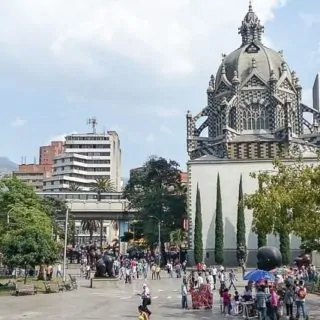
Colombia Travel Tips
Important tips and resources for planning an amazing trip to Colombia, based on my years of traveling and living in Colombia.
Tools
Colombia Trip Planning
Instructions
- Book a cheap flight to Colombia with Momondo, or better yet, start travel hacking so you can fly for free. Traveling between major cities is much better by flying, trust me.
- Plan a rough itinerary and how long you will spend at each destination. Use an itinerary planning service for custom recommendations and pick up Lonely Planet Colombia.
- Work a little every day to teach yourself Spanish, you'll want to know as much as possible before you arrive.
- Book cheap accommodation in advance, at least for the first destinations -- For hostels use: Booking, for cheap hotels use: Hotels.com, for apartments use: Airbnb.
- Reserve your on the ground tours and activities through Get Your Guide.
- Purchase travel insurance for Colombia with SafetyWing to protect yourself from illness, injury, and theft while in Colombia. VERY important. And be sure to read my article: "Is Colombia Safe?" for my honest opinion and safety tips.
- Sign up for my free emails about planning a better trip to Colombia, and be sure to check out my comprehensive guide about traveling to Colombia.
- Learn more money-saving tricks with my top budget travel tips.
- Put together your Colombia packing list.
- Enjoy this incredible country!
Notes
I hope this helped you plan your travels in Colombia! I know it can be a struggle to find accurate and on the ground information when traveling to a new place like Colombia, which is why I started writing so extensively about it!
If you have any questions about Colombia, budget travel, or anything else shoot me an email at ryan@desktodirtbag.com.
(I love getting questions! That is how I get ideas for my blog posts and what to write about!)
Recommended Products
As an Amazon Associate and member of other affiliate programs, I earn from qualifying purchases.
Ryan
Latest posts by Ryan (see all)
- Kazakhstan Food: Exploring Some of its Most Delicious Dishes - August 7, 2023
- A Self-Guided Tour of Kennedy Space Center: 1-Day Itinerary - August 2, 2022
- Fairfield by Marriott Medellin Sabaneta: Affordable and Upscale - July 25, 2022
- One of the Coolest Places to Stay in Clarksdale MS: Travelers Hotel - June 14, 2022
- Space 220 Restaurant: Out-of-This-World Dining at Disney’s EPCOT - May 31, 2022

